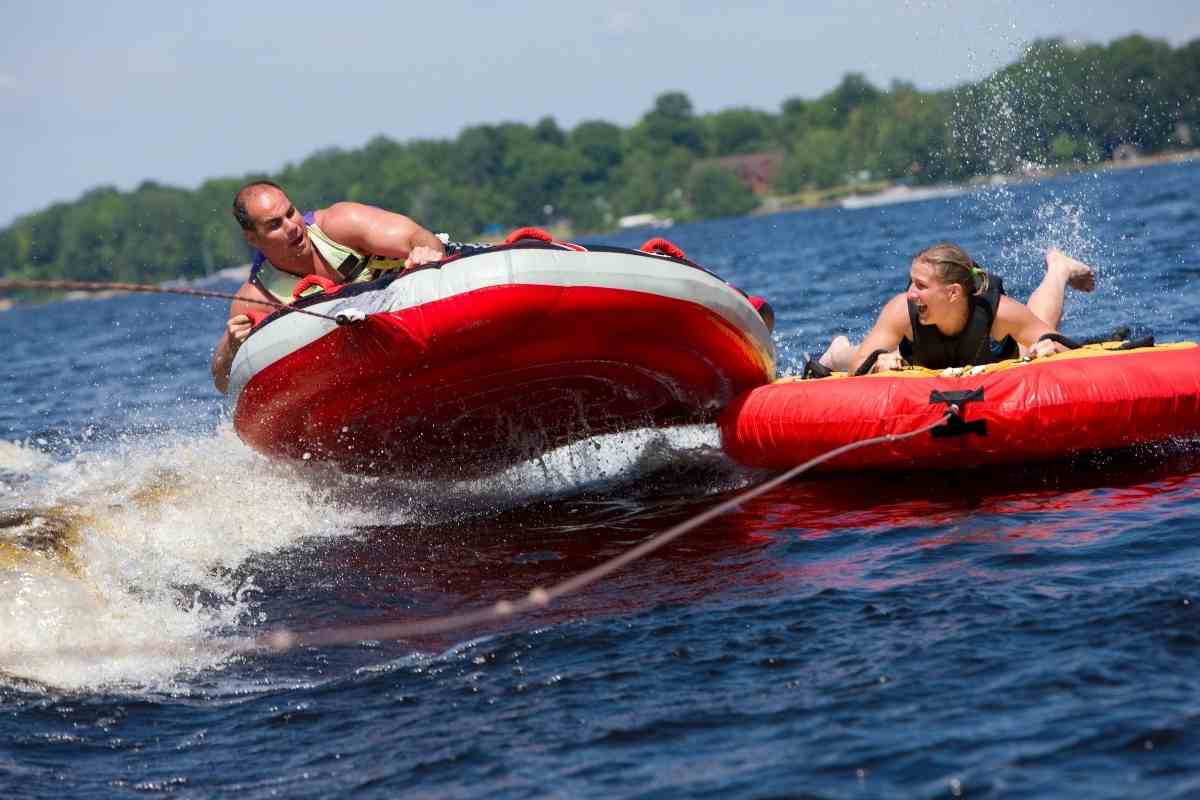How Fast Do You Pull A Tube Behind A Boat?
Tubing is a lot of fun. You can tube behind all kinds of different boats and just about anybody can do it regardless of their experience or skill level with tubing. However, to tube safely it is absolutely essential that you know what speeds are appropriate depending on your rider and the conditions.
You should pull a tube behind a boat at speeds between 8 miles an hour and 20 miles per hour. Lower speeds should be used for children and less than ideal conditions whereas the highest speeds can be utilized with older riders when there are few obstacles and deep water.
Here’s what you need to know about how fast to pull a tube as well as some other important tips for tubing safety.
How Fast To Go When Pulling A Tube
There is a reason that turns are the most fun part of being pulled on a tube. The length of the rope means that the tube goes through a longer arc when the boat turns than does the boat itself.
That means that when you turn your boat, particularly when you make a tight turn, the tube may go twice as fast as the boat. You may feel like you are traveling along at a very reasonable clip, but your tuber may really be flying.
The speed at which it is safe to pull a tuber depends on who is riding and the conditions under which you are pulling. If you are pulling adults or teenagers who are good swimmers and know how to hold on to the tube and you’re in conditions where the water is deep and there are no obstacles around, you can go considerably faster than if you are pulling younger children or if there are potential obstacles in the way.
The quality of the tube will also affect how fast you can go. Cheaper tubes without sturdy attachment points or handles may rip or flip over more easily at higher speeds than high-quality tubes with good handles and a sturdy build.
** 5 Best Towable Boat Tubes the Entire Family Will Enjoy! **
In general, here are the speeds that you should pull a tube behind a boat:
| Very young or inexperienced children | 8 miles per hour |
| Older children in perfect conditions | 12 miles per hour |
| Teenagers or adults with possible obstacles | 15 miles per hour |
| Teenagers or adults in ideal conditions | 20 miles per hour |
How To Pull A Tube Safely
Tubing is one of the easiest and most fun ways to get out on the water and have a blast. Anyone of any age can be pulled on a tube, and it is one of the few options which allow multiple people to all ride together.
It doesn’t take any skill at all to ride a tube, just hold on and have fun. However, pulling a tube does require some care and skill. Tubers can’t release the tube and they can’t steer, so they are completely at your mercy. Since a tube does not need to stay on a plane like a wakeboard or skis, you can always just slow down or stop when you are concerned that there may be some threat to the tube.
You can pull a tube behind just about any kind of powerboat, and hooking it up is very easy. However, navigating the boat safely takes a bit more consideration. Here are some tips to help you tube safely:
Avoid Obstacles
This may seem obvious, but in fact, it can be challenging to think about the turn radius of not just your boat but also the tube that you’re pulling behind when you are navigating. No matter what kind of water you’re on, there are likely to be obstacles in the way.
Channel markers, shorelines, and docks can all be dangerous obstacles. You will need to take into consideration the length of your boat plus the length of the tow line and the tube to establish the minimum distance that you should keep from obstacles.
Keep in mind that even if you are going in a straight line, a sudden gust of wind or wave can easily push the tube out to the side. If you are turning, the tube will arc out in a wide radius, going much further out than your boat will.
If someone should tumble out of the tube when you are turning, they may cover a surprising amount of distance sliding over the water, particularly if they are wearing a life jacket as they should be, so it is essential that you leave a lot of room around obstacles.
Be Wary Of Shallow Water
A tube can typically slide along over even a few inches of water, so it can be tempting to allow the tube to go into shallower water than your boat draws, especially when you are turning. However, if someone falls out of the tube when going over shallow water, they could be seriously injured.
Depending on the conditions, it can be challenging to know where shallow water is. Water currents, storms, and human activity can all change the depth of water. Flats can move hundreds of feet in only a couple of days under certain conditions.
Sometimes a new flat will appear where there was none before. If water conditions are difficult to read, such as if you are navigating into the sun or if water is murky, it may be very difficult to tell where shallow water is. Either operate within channel markers or take your boat around slowly to figure out where shallow areas are before bringing the tube.
Be Wary Of Other Boats
Rarely do you get a waterway to yourself. Even if you are doing your best to keep away from obstacles and other boats, that doesn’t necessarily mean the other boats will be equally respectful.
Other boats may come too close to you and your tuber. The wake that they cause can knock people out of the tube or it can cause the tube to be pushed out of the path directly behind your boat. It can be especially dangerous if boats are passing on both sides of you and the tube is pushed off to the side and into the path of another boat.

It is best to stay firmly on one or the other side of the channel so that other boats will only pass on one side of you. Of course, you must also be careful that the wake from a passing boat does not send the tube into a channel marker.
You need to be especially careful about other boats passing when you are turning. Other boats may not realize how wide the turn radius of the tube is or they may not even notice that you are pulling a tube at all, making it possible that they will cut across the line. If other boats are around when you want to turn, it may be best to slow down and wait for them to pass.
Use A Spotter
It’s not nearly as much fun to watch people enjoying riding in the tube as it is to ride, so it’s very typical to have some struggle to make sure that someone is willing to stay on the boat to be the spotter. However, is extremely important for you to be strict about having a spotter at all times.
You cannot look where you’re going and watch out for obstacles and other boaters at the same time as you keep an eye on the people in the tube. Tubers fall out of the tube very easily. After all, this is part of the fun of tubing.
However, a person treading water in the channel can be very dangerous. It’s extremely hard for other boaters to see someone in the water with just their head and arms above the surface. Other boaters won’t expect swimmers to be out this far.
While wakeboarders or skiers can hold their skis or board out of the water to increase visibility, tubers do not have this option. They don’t even have the tube anywhere near them to draw attention since it continues to be dragged after the boat.
Without a spotter, you may not notice that someone has fallen out of the tube for some time. Other people in the tube have no way of communicating to you that someone has fallen out if there isn’t a spotter to watch.
Some states require boaters to fly an orange flag when a rider is down, but not everybody will notice this flag or know what it means. Furthermore, you won’t be able to fly the orange flag unless you notice that somebody is down. Therefore, it is absolutely essential to always use a spotter when you are tubing.
Enjoy Tubing Safely

Tubing at appropriate speeds is absolutely essential for the safety of the people in the tube. It may not feel like you’re going very fast when you are tubing at safe speeds, but it is always better to be safe than sorry.
If you feel that the ride isn’t exciting enough, try taking more twists and turns, aim for waves, or use a smaller and lighter tube.
